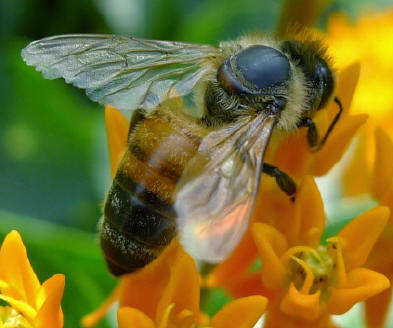Last flight of the Bumblebee
Tim Iverson
Naturalist
 (6/2015) There has been a lot of buzz in the news lately about bees and other pollinators. It may even come across as alarmist and sensationalistic fear mongering with titles such as, "Bee-pacalypse: The End of The World". Full disclosure, that wasnít an actual title Iíve come across, but it
might as well be. The truth is that with the sudden and rapid decimation of bee and other pollinator populations weíre in for an uncertain and costly future, and that is alarming.
(6/2015) There has been a lot of buzz in the news lately about bees and other pollinators. It may even come across as alarmist and sensationalistic fear mongering with titles such as, "Bee-pacalypse: The End of The World". Full disclosure, that wasnít an actual title Iíve come across, but it
might as well be. The truth is that with the sudden and rapid decimation of bee and other pollinator populations weíre in for an uncertain and costly future, and that is alarming.
Pollinators serve a vital and irreplaceable role in our world. The word pollinator immediately conjures up images of bees, specifically honey bees. While bees are an important pollinator they donít have the market cornered. Other pollinators include bats, birds, beetles, moths, butterflies, and small mammals. Pollination is the process by which pollen
from flowering plants is spread. In a recent report from the USDA it is estimated that, "Pollinators, most often honey bees, are also responsible for one in every three bites of food we take, and increase our nationís crop values each year by more than 15 billion dollars." With the sudden inexplicable loss of a significant pollinator we should be alarmed.
For the past decade honey bees have suffering from what is called Colony Collapse Disorder, or CCD. CCD, by definition, is a colony with either no adult bees or surrounded by dead bees but with a live queen and may or may not have honey or immature bees. It is still largely not understood and happening in droves.
Beekeepers reportedly lost 42% of their colonies over the last year alone. Even more troubling is much of this loss occurred during the summer months which is unusual. This has become such a systemic problem that it now has the full weight of the federal government behind it.
Launched in 2014 The White House began a Pollinator Health Task Force. On May 19 this task force unveiled their national strategy to promote the health of honey bees and other pollinators. The goal of which is to devote more money to research on pollinators, educate the public on the importance of protecting honeybees and monarch butterflies, reexamine
the use of widely used pesticides, change landscaping techniques on federally controlled lands and property, and to restore and develop roughly 7 million acres of pollinator habitat.
Leading the charge on this is the Environmental Protection Agency, which has put a freeze on new uses of a class of chemicals known as neonicotinoids until further research has been done, and the Department of Agriculture. Neonicotinoids are often cited as the culprit behind the staggering losses, but a recent study from the University of Maryland
found otherwise.
The study, which was published in March 2015, closely examined the effect of imidacloprid (a type of neonicotinoid pesticide) on honeybees over the course of three years. Interestingly the study found that in real world dosage levels the pesticide did not have a significant impact. Only at levels of at least four times normal dosage did the pesticide
have significant impacts. Neonicotinoids arenít entirely absolved by this study. "Everyone is pointing the finger at these insecticides.
If you pull up a search on the Internet, thatís practically all anyone is talking about...This paper says no, itís not the sole cause. It contributes, but there is a bigger picture," said Galen Dively, emeritus professor of entomology at UMD and lead author of the study. According to the researchers, the test colonies for the study were treated well
and werenít subjected to any additional real world stressors, such as multiple pesticides or malnourishment. "Itís a multifactorial issue, with lots of stress factors...Honey bees have a lot of pests and diseases to deal with. Insecticide exposure is one factor among many. Itís not the lone villain," Dively said.
While the government and universities are diving head first into the problem there is a lot a private citizen can do help the cause too. Selecting certain plants to encourage pollinators will attract and strengthen local species. Plants like milkweed, ironweed, coneflower, goldenrod, and asters are favorites of pollinators as they provide food and
habitat. Providing nesting sites by planting these plants will encourage population growth, but you can also include bee nesting blocks. Nesting blocks can be purchased or made by bundling hollow stems (usually bamboo) horizontally together.
Of course, as the study and EPA, have indicated pesticides are a contributing factor. Avoid using them, when and if you can, as they can still have an impact days after application. You can encourage predatory insects, birds, reptiles, amphibians, and mammals by planting specific types of native plants. The University of Maryland has a great resource
for Integrated Pest Management control available online.
What is clear from the information we currently have is that nothing is immediately clear. With time and a cautious approach we can hopefully reverse the downward spiral. While more research into the issue is underway there are meaningful avenues we can take to mitigate losses. Native pollinators contribute billions to the economy and ecosystem and are
too significant to idly let them vanish. Human intervention is likely required to tackle a human caused problem, and an all hands on deck approach is important to protect and encourage these species. By being proactive, being responsible, and being stewards weíll be okay.
Read other articles by Tim Iverson